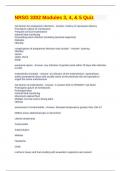Exam (elaborations)
NRSG 3302 Modules 3, 4, & 5 Questuions and Answers
- Course
- Institution
NRSG 3302 Modules 3, 4, & 5 Quiz risk factors for postpartum infections - Answer- History of caesarean delivery Premature rupture of membranes Frequent cervical examination Internal fetal monitoring Preexisting pelvic infection (including bacterial vaginosis) Diabetes Obestity complicat...
[Show more]



